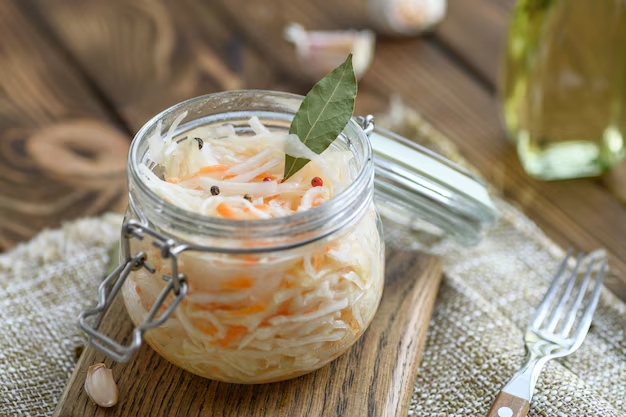Does Horseradish Expire in the Refrigerator? Discover the Truth and How to Keep it Fresh
Horseradish is a pungent, versatile condiment that can add a spicy kick to various dishes. But like any other fresh food item, there comes a time when you might wonder, “Does horseradish go bad in the refrigerator?” Let's delve into this flavorful subject to uncover the storage secrets that keep horseradish fresh, its signs of spoilage, and how it fits within your kitchen’s ecosystem.
Understanding the Shelf Life of Horseradish
What Makes Horseradish So Unique?
Horseradish is a root vegetable known for its intense aroma and spicy flavor, derived from the compounds released when the root is crushed. Typically grated and combined with vinegar, it becomes the familiar condiment often accompanying roast beef and other hearty meals. Its high sulfur content is what gives it that distinct nose-tingling quality.
How Long Does Horseradish Last in the Refrigerator?
When unopened, a jar of prepared horseradish can last several months past its best-by date, thanks to preservatives and the natural antimicrobial properties of vinegar. However, once opened, the situation changes. Generally, refrigerated horseradish remains fresh for about 3 to 4 months after opening, assuming proper storage. Grated fresh horseradish, on the other hand, tends to have a shorter shelf life of 3 to 4 weeks.
Factors Affecting Horseradish Shelf Life
Several elements influence how long horseradish remains usable:
- Temperature: Consistently cold temperatures help maintain freshness.
- Exposure to Air: Air causes oxidation, altering the flavor and potency.
- Moisture: Humidity can expedite mold growth and spoilage.
Quick Tips for Extending Shelf Life:
- Always use a clean spoon to avoid contamination.
- Store in a tight-sealing jar to minimize air exposure.
- Keep it at the back of the fridge where temperatures are most stable.
Recognizing Spoiled Horseradish
Signs Your Horseradish is Past its Prime
While horseradish generally has a long shelf life, it can still spoil. Look for these tell-tale signs:
- Color Change: Fresh horseradish is creamy white. If it turns dark or develops spots, it’s a sign of oxidation or mold.
- Texture: A mushy consistency indicates breakdown due to moisture.
- Smell: An unusually sharp or foul odor could signify spoilage.
- Taste: If the heat is gone, so is the horseradish's essence. A flat or sour taste suggests it’s time to toss it.
The Health Risks of Consuming Spoiled Horseradish
Eating spoiled horseradish can lead to digestive discomfort, though it's unlikely to cause severe health issues. The primary concern is a lack of flavor rather than toxicity.
Proper Storage Techniques
Best Practices for Storing Horseradish
To keep horseradish fresh and potent:
- Keep it Sealed: Ensure the jar lid is tight to minimize air exposure.
- Store in the Original Container: If possible, use the container it came in, which is designed for its storage needs.
- Refrigerate Immediately: After using, return it to the fridge promptly to maintain its chill.
- Avoid Cross-Contamination: Use clean utensils to prevent introducing bacteria.
Can You Freeze Horseradish?
Freezing is an option but is generally discouraged as it can affect texture and potency. If you choose to freeze it, do so in small quantities, ideally in an ice cube tray, to prevent waste and maintain convenience.
The Role of Horseradish in Your Refrigerator Ecosystem
Complementary Items in Your Fridge
Horseradish pairs well with numerous foods that may already reside in your fridge:
- Roast Meats: Adds a spicy zing to beef, pork, and chicken.
- Salads: Incorporate into dressings for a peppery kick.
- Sandwiches: A spicy alternative to standard spreads.
- Seafood: Perfect with smoked salmon or shrimp cocktails.
Balancing the Fridge’s Aroma
Horseradish’s strong smell can influence the olfactory balance of your fridge. Here are ways to keep it under control:
- Charcoal or Baking Soda: These natural deodorizers can help absorb strong odors.
- Airtight Containers: An extra layer can buffer the smell.
Refresh and Revitalize
When horseradish starts to lose its punch, refreshing it with a touch of vinegar and a pinch of salt can help revive it temporarily.
📝 Quick Reference: Horseradish Handling
Here’s a handy summary to keep things fresh and spicy:
- 🕒 Shelf Life: 3-4 months once opened in the fridge.
- ❗ Signs of Spoilage: Discoloration, off smell, and loss of flavor.
- 📦 Storage Tips: Keep sealed, chilly, and away from excess air.
- 🚫 Avoid: Freezing unless necessary; it may alter texture.
- 🍽 Pair with: Roast meats, sandwiches, salads, and seafood.
Conclusion
Horseradish brings a fiery flair to your meals, but like any culinary delight, its freshness can fade. Following the correct storage practices ensures you enjoy its spicy character longer. Remember to look for signs of spoilage before using it to ensure it enhances rather than detracts from your culinary creations. Whether you're a fan of a mild tingle or a powerful punch, treating horseradish with care will keep it a vibrant staple in your fridge. Engage your senses and enjoy the zest that horseradish adds to your palate!
